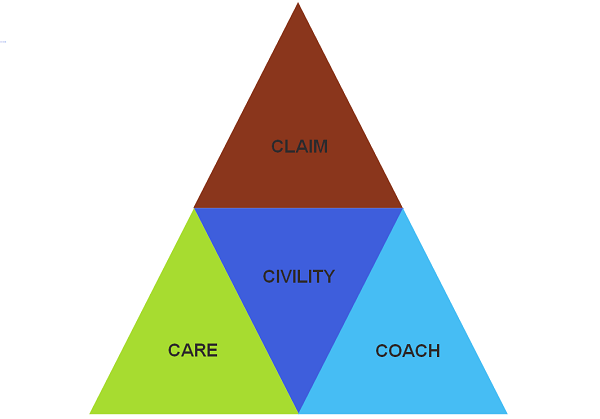A Coaching Model Created by Martina Muttke
(Executive Coach, SWITZERLAND)
Supporting the journey to better leadership in executive coaching
 Despite what we believe about the necessities of having certain skills as a leader, the reality shows that, “soft“ items dominate the expectations employees have for their leader:
Despite what we believe about the necessities of having certain skills as a leader, the reality shows that, “soft“ items dominate the expectations employees have for their leader:
- Demonstrate Integrity
- Show and Teach Responsibility
- Create Motivation and Empowerment
- Provide an environment of Safety and Trust
The behaviour of a leader needs to match the values of- CIVILITY
What is Civility?
Civility is claiming and caring for one’s identity, needs and beliefs without degrading someone else’s in the process
Civility is about more than just politeness, although politeness is a necessary first step. It is about disagreeing without disrespect, seeking common ground as a starting point for dialogue about differences, listening past one’s preconceptions, and teaching others to do the same.
Civility is the hard work of staying present even with those with whom we have deep-rooted and fierce disagreements.

The Path to Coaching Civility
Step 1: Explore your awareness about the key values that express Civility
Do you pay attention? Do you acknowledge others? Do you listen? Are you inclusive? Do you accept differences? Do you accept and give praise? Do you respect others‘ time, space and opinions? Are you able to apologize? Are you truly assertive? Are you able to accept and give non-judgmental criticism? Do you care about yourself? Do you care about your environment, and other people?
Ask yourself how much of your current behaviour is in line with Civility!
Step 2: Learning Civility
Civility is the hard work of staying present even with those with whom we have deep-rooted and fierce disagreements
Step 3: Transform yourself into a better leader with Civility
Civility pays. It enhances your influence and performance — and is positively associated with being perceived as a leader
Ask for feedback on your best behaviors. This technique, originated by researcher Laura Roberts, will help you see your most respectful self. Collect feedback from about 10 people (family, friends, coworkers). Ask each for positive examples of your best behaviour. When and how have they seen you treat people well? After compiling the feedback, organize and summarize. Then, look for patterns. When, how, with whom are you at your best? Use these insights to reinforce what you are doing well. Be mindful of all opportunities to be your best, civil self.
Step 3: Transform yourself into a better leader with Civility
Discover your shortcomings. Gather candid feedback from your colleagues and friends not only on what you’re doing well, but also on how you can improve.
Specifically, what are your shortcomings? Identify a couple of friends and trusted colleagues who have the best intentions for you and your organization.
Ask people from whom you will receive direct and honest feedback. Ask for their views about how you treat other people. What do you do well? What could you do better? Listen carefully.
Step 4: Transform yourself into a better leader with Civility
Live, transfer and teach Civility.
Leaders have an important role to play in creating a culture of civility. They need to role model expected leadership behaviours, and are accountable to ensure that civility expectations are being enforced within their organization
Create your declaration of civility by defining the common theme, provide and outline concrete behaviours
Give guidance on behaviour in “peaceful” times as well as times of conflict
Outline mechanisms to repair relationships and civil behaviour when relationships become strained
 (*) Marini, Z. A., Polihronis, C., & Blackwell, W. (2010). Academic in/civility: Co-constructing the foundation for a civil learning community. Collected Essays on Learning and Teaching, 3, 89-93.
(*) Marini, Z. A., Polihronis, C., & Blackwell, W. (2010). Academic in/civility: Co-constructing the foundation for a civil learning community. Collected Essays on Learning and Teaching, 3, 89-93.